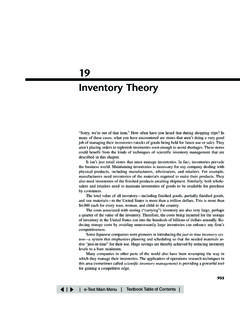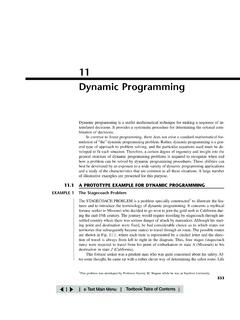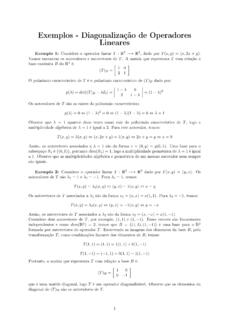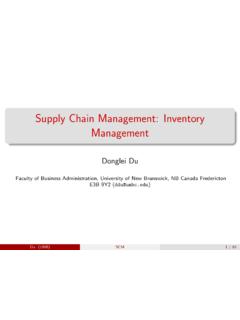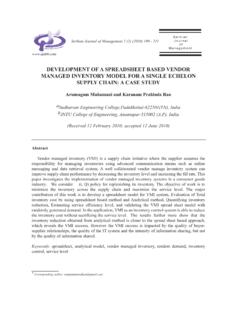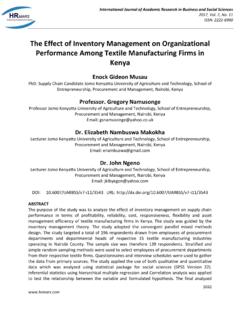Transcription of Chapter 19 Inventory Theory - Unicamp
1 93519 Inventory Theory Sorry, we re out of that item. How often have you heard that during shopping trips? Inmany of these cases, what you have encountered are stores that aren t doing a very goodjob of managing their inventories(stocks of goods being held for future use or sale). Theyaren t placing orders to replenish inventories soon enough to avoid shortages. These storescould benefit from the kinds of techniques of scientific Inventory management that aredescribed in this isn t just retail stores that must manage inventories. In fact, inventories pervadethe business world. Maintaining inventories is necessary for any company dealing withphysical products, including manufacturers, wholesalers, and retailers.
2 For example,manufacturers need inventories of the materials required to make their products. Theyalso need inventories of the finished products awaiting shipment. Similarly, both whole-salers and retailers need to maintain inventories of goods to be available for purchaseby total value of all Inventory including finished goods, partially finished goods,and raw materials in the United States is more than a trilliondollars. This is more than$4,000 each for every man, woman, and child in the costs associated with storing ( carrying ) Inventory are also very large, perhapsa quarter of the value of the Inventory . Therefore, the costs being incurred for the storageof Inventory in the United States run into the hundreds of billions of dollars annually.
3 Re-ducing storage costs by avoiding unnecessarily large inventories can enhance any firm Japanese companies were pioneers in introducing the just-in-time Inventory sys-tem a system that emphasizes planning and scheduling so that the needed materials ar-rive just-in-time for their use. Huge savings are thereby achieved by reducing inventorylevels to a bare companies in other parts of the world also have been revamping the way inwhich they manage their inventories. The application of operations research techniques inthis area (sometimes called scientific Inventory management) is providing a powerful toolfor gaining a competitive do companies use operations research to improve their Inventory policyforwhen and how much to replenish their Inventory ?
4 They use scientific Inventory man-agementcomprising the following a mathematical modeldescribing the behavior of the Inventory an optimalinventory policy with respect to this a computerized information processing systemto maintain a record of the currentinventory this record of current Inventory levels, apply the optimal Inventory policy to sig-nal when and how much to replenish mathematical Inventory models used with this approach can be divided into twobroad categories deterministic models and stochastic models according to the pre-dictability of demandinvolved. The demandfor a product in Inventory is the number ofunits that will need to be withdrawn from Inventory for some use ( , sales) during aspecific period.
5 If the demand in future periods can be forecast with considerable preci-sion, it is reasonable to use an Inventory policy that assumes that all forecasts will alwaysbe completely accurate. This is the case of known demandwhere a deterministicinven-tory model would be used. However, when demand cannot be predicted very well, it be-comes necessary to use a stochasticinventory model where the demand in any period isa random variable rather than a known are several basic considerations involved in determining an Inventory pol-icy that must be reflected in the mathematical Inventory model . These are illustratedin the examples presented in the first section and then are described in general termsin Sec.
6 Section develops and analyzes deterministic Inventory models forsituations where the Inventory level is under continuous review. Section does thesame for situations where the planning is being done for a series of periods rather thancontinuously. The following three sections present stochastic models, first under con-tinuous review, then for a single period, and finally for a series of periods. The chap-ter concludes with a discussion of how scientific Inventory management is being usedin practice to deal with very large Inventory systems, as illustrated by case studies atIBM and Inventory THEORYWe present two examples in rather different contexts (a manufacturer and a wholesaler)where an Inventory policy needs to be EXAMPLESEXAMPLE 1 Manufacturing Speakers for TV SetsA television manufacturing company produces its own speakers, which are used in theproduction of its television sets.
7 The television sets are assembled on a continuous pro-duction line at a rate of 8,000 per month, with one speaker needed per set. The speak-ers are produced in batches because they do not warrant setting up a continuous pro-duction line, and relatively large quantities can be produced in a short time. Therefore,the speakers are placed into Inventory until they are needed for assembly into televisionsets on the production line. The company is interested in determining when to producea batch of speakers and how many speakers to produce in each batch. Several costs mustbe time a batch is produced, a setup costof $12,000 is incurred.
8 This cost includesthe cost of tooling up, administrative costs, record keeping, and so forth. Note thatthe existence of this cost argues for producing speakers in large unit production costof a single speaker (excluding the setup cost) is $10, inde-pendent of the batch size produced. (In general, however, the unit production cost neednot be constant and may decrease with batch size.) production of speakers in large batches leads to a large Inventory . The estimatedholding costof keeping a speaker in stock is $ per month. This cost includes thecost of capital tied up in Inventory . Since the money invested in Inventory cannot beused in other productive ways, this cost of capital consists of the lost return (referred toas the opportunity cost) because alternative uses of the money must be forgone.
9 Othercomponents of the holding cost include the cost of leasing the storage space, the costof insurance against loss of Inventory by fire, theft, or vandalism, taxes based on thevalue of the Inventory , and the cost of personnel who oversee and protect the policy prohibits deliberately planning for shortages of any of its , a shortage of speakers occasionally crops up, and it has been estimated thateach speaker that is not available when required costs $ per month. This shortagecostincludes the extra cost of installing speakers after the television set is fully as-sembled otherwise, the interest lost because of the delay in receiving sales revenue, thecost of extra record keeping, and so will develop the Inventory policy for this example with the help of the first in-ventory model presented in Sec.
10 EXAMPLES937 EXAMPLE 2 Wholesale Distribution of BicyclesA wholesale distributor of bicycles is having trouble with shortages of a popular model (a small, one-speed girl s bicycle) and is currently reviewing the Inventory policy for thismodel. The distributor purchases this model bicycle from the manufacturer monthly andthen supplies it to various bicycle shops in the western United States in response to pur-chase orders. What the total demand from bicycle shops will be in any given month isquite uncertain. Therefore, the question is, How many bicycles should be ordered fromthe manufacturer for any given month, given the stock level leading into that month?
